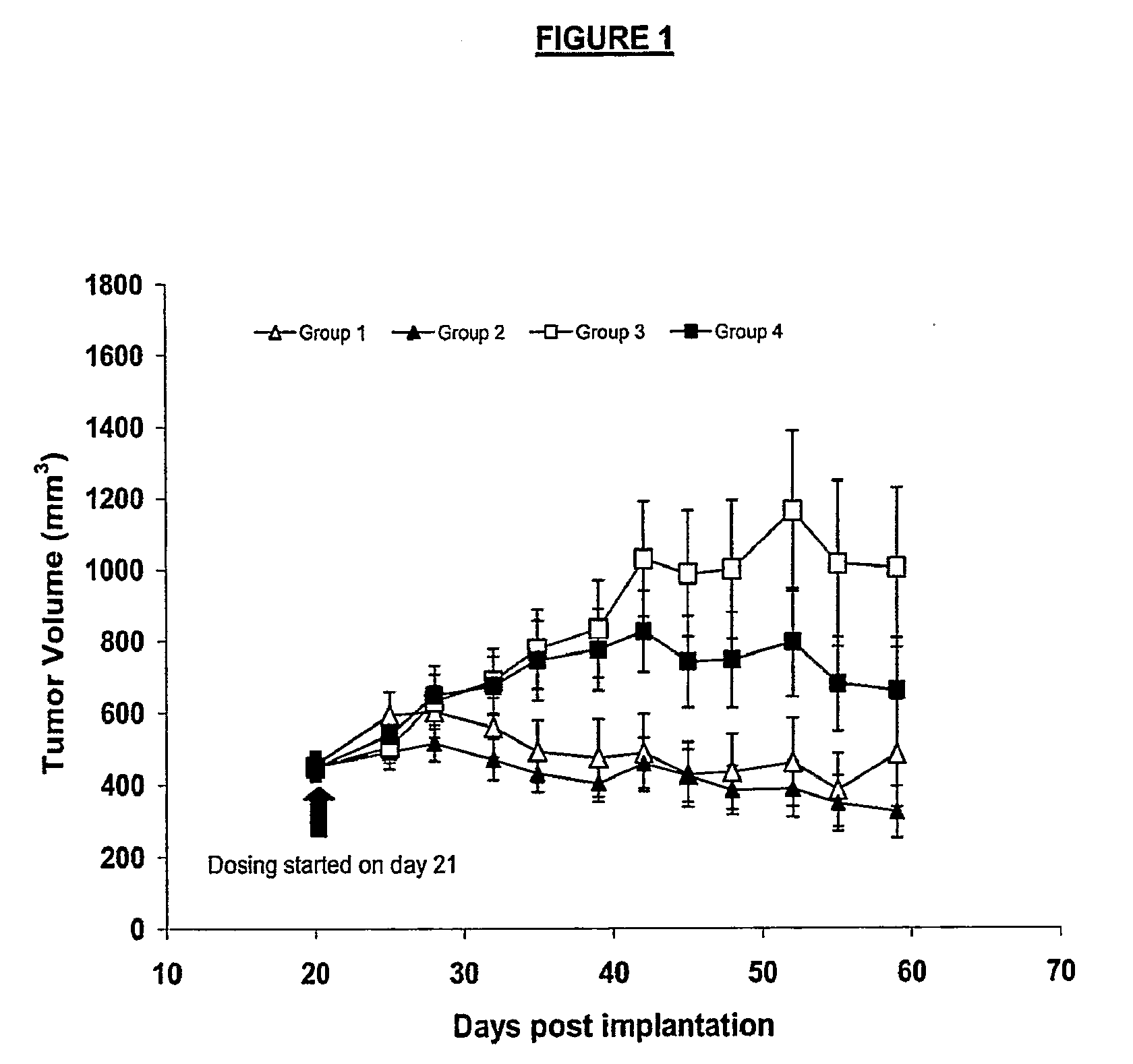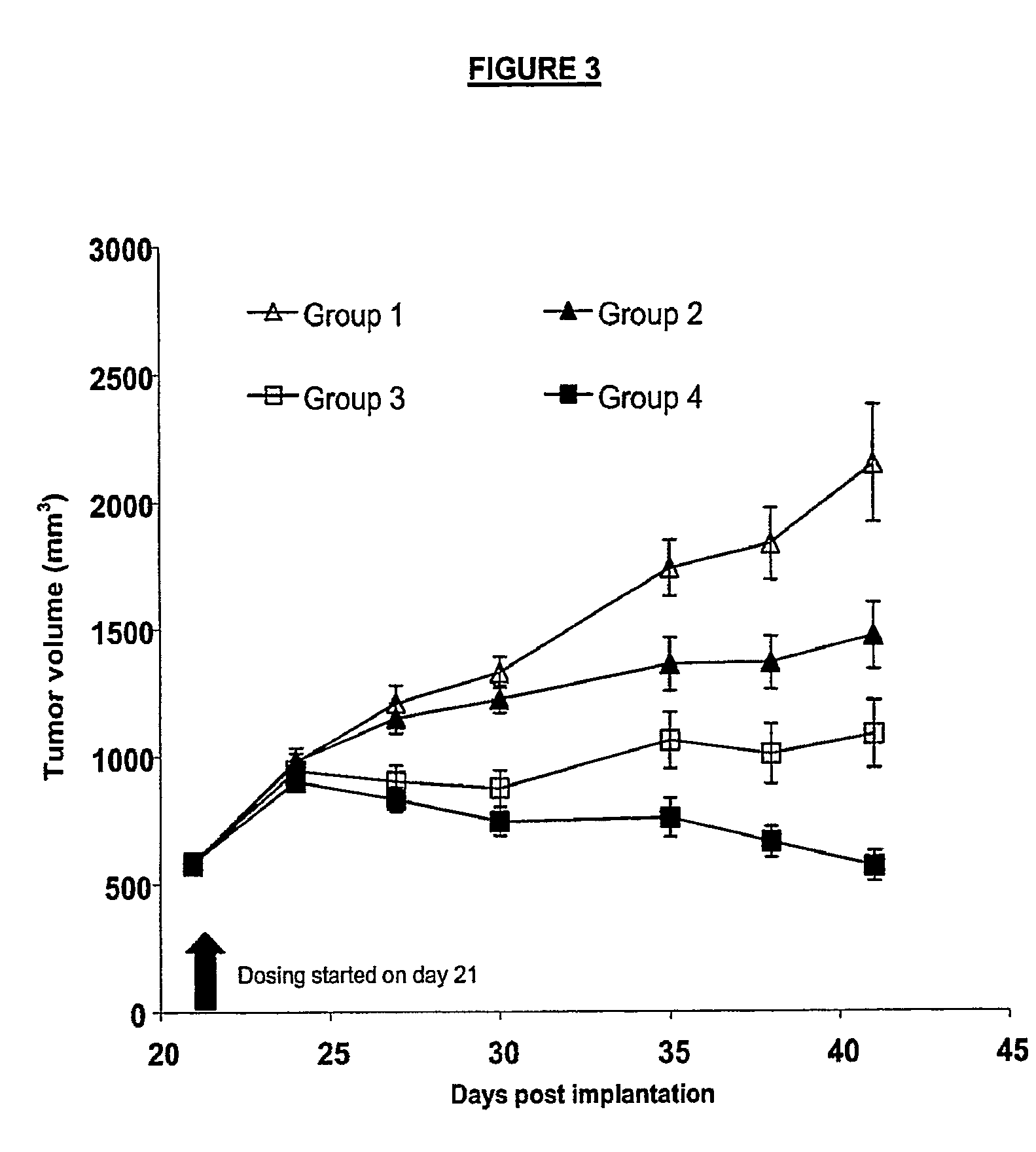Ang2 and Vegf Inhibitor Combinations
a technology of ang2 and vegf, which is applied in the field of combination of ang2 inhibitors and vegf inhibitors, can solve the problems that none of them has proved to be an entirely satisfactory way to provide monotherapeutic modality, and the amount of doses cannot be provided in the amount required by injection, so as to improve the utility of patient treatment
- Summary
- Abstract
- Description
- Claims
- Application Information
AI Technical Summary
Benefits of technology
Problems solved by technology
Method used
Image
Examples
example 1
Tek472 / Fc and Avastin™
[0325]Xenografts of Colo205 cells injected into female CD1 Nu / Nu mice were treated with: (1) Avastin™ (group 1); (2) both Avastin™ and Tek472 / Fc (group 2); (3) HuIgG1 and Fc control (group 3), and (4) Tek472 / Fc (group 4), as described in greater detail below.
[0326]Tumors were induced by injecting Colo205 cells into forty CD1 Nu / Nu female mice, 6 to 8 weeks of age, weighing between 20 and 22 grams. All of the mice were obtained from Charles River Laboratories (Raleigh, N.C., APR# 245658). Colo205 cells for injection were cultured in suspension at 37° C. in McCoy5A medium (Gibco / BRL, Grand Island, N.Y.) supplemented with 10% FBS (Hyclone, Logan, Utah). For injection, cells were harvested from culture and mixed with Matrigel™ (BD Bioscience, Bedford, Mass., Cat#354234) to a concentration of 1×107 cells / ml. 0.2 ml of the cell-Matrigel™ mixture containing 2×106 Colo205 cells was injected into the right flank of each mouse subcutaneously. Mice then were randomly assi...
example 2
Anti-Ang2 (Ab 536) and Anti-VEGF
[0334]Xenografts of A431 cells injected into female CD1 Nu / Nu mice were treated with: (1) control human IgG1 (kappa); (2) anti-Ang2 antibody (Ab 536); (3) anti-VEGF antibody; and (4) both anti-VEGF antibody and anti-Ang2 antibody (Ab 536), as presented in greater detail in Tables 2A and 2B and in the discussion below.
TABLE 2AGroup No.No of MiceTreatment110Control human IgG1 (kappa)210Anti-Ang2 (Ab 536)310Anti-VEGF + Control IgG1 (kappa)410Anti-VEGF + Anti-Ang2 (Ab 536)
TABLE 2BAnti-Ang2Human IgG1AB 536KappaAnti-VEGFSuppliern / aSigmaR&DVehiclePBSPBSPBSDoseFirst dose 140 μg,First dose 140 μg,First dose 15.5 μg,then 46.7 μg eachthen 46.7 μg eachthen 5.18 μg eachdosedosedoseRouteIPIPIPSchedule3× / week3× / week3× / weekMiceCD1 Nu / Nu, Female, Charles River Laboratories
[0335]The A431 cells were cultured in T-225 flasks. After 40 passages, cells for the study were grown until they were 80-85% confluent and then harvested using trypsin / EDTA. Harvested cells were susp...
example 3
2xCon4(C) and AMG 706-HT29 Xenografts
[0345]Xenografts of HT29 cells injected into female athymic nude mice were treated with 2xCon4(C) alone, AMG 706 alone, or a combination of the two, as described below.
[0346]Tumors were induced by injecting HT29 cells subcutaneously into 90 female athymic nude mice, 6 to 8 weeks of age, weighing between 21 and 23 grams. All of the mice were obtained from Harlan Sprague Dawley. HT29 cells for injection were cultured in suspension at 37° C. in McCoy5A1 medium (Gibco / BRL, Grand Island, N.Y.) supplemented with 10% FBS (Hyclone, Logan, Utah). After 26 passages, cells for the study were grown until they were semi-confluent (approximately 40%) and then harvested using trypsin / EDTA. Cells were mixed with Matrigel™ (BD Bioscience, Bedford, Mass., Cat#354234) in a ratio of 2:1 to a concentration of 1×107 cells / ml. Greater than 95% of the cells were viable as determined by trypan blue exclusion. 0.2 ml of the cell-Matrigel™ mixture containing 2×106 HT29 cel...
PUM
| Property | Measurement | Unit |
|---|---|---|
| diameter | aaaaa | aaaaa |
| concentration | aaaaa | aaaaa |
| volumes | aaaaa | aaaaa |
Abstract
Description
Claims
Application Information
 Login to View More
Login to View More - R&D
- Intellectual Property
- Life Sciences
- Materials
- Tech Scout
- Unparalleled Data Quality
- Higher Quality Content
- 60% Fewer Hallucinations
Browse by: Latest US Patents, China's latest patents, Technical Efficacy Thesaurus, Application Domain, Technology Topic, Popular Technical Reports.
© 2025 PatSnap. All rights reserved.Legal|Privacy policy|Modern Slavery Act Transparency Statement|Sitemap|About US| Contact US: help@patsnap.com



